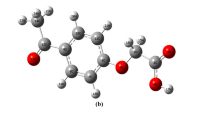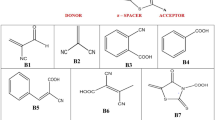Abstract
Abstract
Analogs of 2-[(2Z)-2-[[4-(dihexylamino)-2-methylphenyl]methylidene]-1,1-dioxo-1-benzothiophen-3-ylidene]propanedinitrile (Foron blue SR, Disperse Blue 354) are studied in terms of photophysical, structural aspects and its nonlinear optical properties evaluated by using Density Functional Theory (DFT) and Time Dependent Density Functional Theory (TD-DFT). The structures were optimized by using function B3LYP and basis set used was 6-31G(d). Polarizability (\(\alpha \)), first and second order hyperpolarizability (\(\beta \) and \(\gamma \)) was determined by three density functionals B3LYP, CAM-B3LYP and BHandHLYP. B3LYP functional and the basis set 6-311+G(d,p) shows high values of \(\alpha \), \(\beta \) and \(\gamma \). The B3LYP functional gives the highest first order hyperpolarizability value for (Z)-2-(2-(4-(dimethylamino)benzylidene)-1,1-dioxidobenzo[b]thiophen-3(2H)-ylidene)malononitrile (3a) is \(373.31 \times 10^{-30}\) e.s.u and \(486.32 \times 10^{-30}\) e.s.u in ethylacetate and dimethylformamide respectively. Effect of bond length alteration (BLA) and bond order alteration (BOA) on first order hyperpolarizability was evaluated. Intrinsic hyperpolarizability shows the compound (Z)-2-(4-(dimethylamino)benzylidene)benzo[b]thiophen-3(2H)-one 1,1-dioxide (1a) intrinsically good. Perturbation potential is found to decrease as absorption energy deceases and hyperpolarizability increases.
Graphic Abstract:
Analogs of Foron blue SR which is also known as Disperse Blue 354 are studied in terms of photophysical, structural aspects and its nonlinear optical properties evaluated by using Density Functional Theory (DFT) and Time Dependent Density Functional Theory (TD-DFT). The structures were optimized by using the functional, B3LYP and the basis set used was 6-31G(d). Polarizability (\(\alpha \)), first and second order hyperpolarizability (\(\beta \) and \(\gamma \)) were determined by three density functionals B3LYP, CAM-B3LYP and BHandHLYP. B3LYP and the basis set 6-311+G(d,p) shows high values of \(\alpha \), \(\beta \) and \(\gamma \). The B3LYP functional gives the highest first order hyperpolarizability for (Z)-2-(2-(4-(dimethylamino)benzylidene)-1,1-dioxidobenzo[b]thiophen-3(2H)-ylidene)malononitrile (3a), \(373.31 \times 10^{-30}\) e.s.u and \(486.32 \times 10^{-30}\) e.s.u in ethylacetate and dimethylformamide respectively. Effect of bond length alteration (BLA) and bond order alteration (BOA) on first order hyperpolarizability was evaluated. Intrinsic hyperpolarizability shows that the compound (Z)-2-(4-(dimethylamino)benzylidene)benzo[b]thiophen-3(2H)-one 1,1-dioxide (1a) intrinsically good. Perturbation potential is found to decrease as absorption energy deceases and hyperpolarizability increases.











Similar content being viewed by others
References
Rao Y L and Wang S 2011 Four-coordinate organoboron compounds with a \(\pi \)-conjugated chelate ligand for optoelectronic applications Inorg. Chem. 50 12263
Entwistle C D and Marder T B 2004 Applications of three-coordinate organoboron compounds and polymers in optoelectronics Chem. Mater. 16 4574
Gieseking R L, Mukhopadhyay S, Risko C and Marder S R 2014 Design of polymethine dyes for all-optical switching applications: guidance from theoretical and computational studies Adv. Mater. 26 68
Polander L E, Pandey L, Barlow S, Tiwari S P, Risko C, Kippelen B, Brédas J-L and Marder S R 2011 Benzothiadiazole-dithienopyrrole donor- acceptor-donor and acceptor-donor-acceptor triads: synthesis and optical, electrochemical, and charge-transport properties J. Phys. Chem. C 115 23149
Rana M, Singla N, Chatterjee A and Shukla A 2016 Investigation of nonlinear optical (NLO) properties by charge transfer contributions of amine functionalized tetraphenylethylene Opt. Mater. 62 80
Wang X, Mi Y, Wang D, He W, Cao H and Yang H 2016 Third-order nonlinear optical properties of a novel series of azobenzene liquid crystal derivatives Mol. Cryst. Liq. Cryst. 630 1
Breitung E M, Shu C-F and Mcmahon R J 2000 Thiazole and thiophene analogues of donor - acceptor stilbenes: Molecular hyperpolarizabilities and structure - property relationships J. Am. Chem. Soc. 122 1154
Meshulam G, Berkovic G and Kotler Z 2000 Electric field induced second harmonic generation with and without fringes Rev. Sci. Instrum. 71 3490
Abdel-Halim H M 2003 Electric field induced second harmonic generation: second and third-order hyperpolarizabilities of 4-amino-4\(\prime \)-nitrodiphenyl sulfoxide J. Chem. Phys. 119 484
Hsu C-C, Huang T-H, Zang Y-L, Lin J-L, Cheng Y-Y, Lin J T, Wu H H, Wang C H, Kuo C-T and Chen C-H 1996 Hyperpolarizabilities of the m-substituent phenyl amine based chromophores determined from the hyper-Rayleigh scattering and two photon absorption induced fluorescence J. Appl. Phys. 80 5996
Joulaud C, Mugnier Y, Djanta G, Dubled M, Marty J-C, Galez C, Wolf J-P, Bonacina L and Le Dante R 2013 Characterization of the nonlinear optical properties of nanocrystals by hyper Rayleigh Scattering J. Nanobiotechnol. 11 S8
Lanke S K and Sekar N 2016 Coumarin push-pull NL ophores with red emission: solvatochromic and theoretical approach J. Fluoresc. 26 949
Krawczyk P 2010 DFT study of linear and nonlinear optical properties of donor-acceptor substituted stilbenes, azobenzenes and benzilideneanilines J. Mol. Model. 16 659
Tang G, Zhao J, Jiang Z, Kou S, Xu J and Wei C 2012 DFT and ab initio study on non-linear optical (NLO) properties of some organic complexes with different conjugate linker and substituent groups Opt. Spectrosc. 113 240
Yanai T, Tew D P and Handy N C 2004 A new hybrid exchange–correlation functional using the Coulomb-attenuating method (CAM-B3LYP) Chem. Phys. Lett. 393 51
Oudar J L and Chemla D S 1977 Hyperpolarizabilities of the nitroanilines and their relations to the excited state dipole moment J. Chem. Phys. 66 2664
Chemla D S, Oudar J L and Jerphagnon J 1975 Origin of the second-order optical susceptibilities of crystalline substituted benzene Phys. Rev. B 12 4534
Thorat K G, Bhakhoa H, Ramasami P and Sekar N 2014 NIR-emitting boradiazaindacene fluorophores TD-DFT studies on electronic structure and photophysical properties J. Fluoresc. 25 69
Shenoy V U, Pate1 V P and Seshadri S 1989 Disperse dyes derived from 3-Oxo-2,3-dihydrobenzo-[b] thiophene-1,1-dioxide and 3-dicyanomethylene-2,3-dihydrobenzo[ b] thiophene-1,1-dioxide Dye. Pigm. 11 37
Frisch M J, Trucks G W, Schlegel H B, Scuseria G E, Robb M A, Cheeseman J R and Scalmani G et al., 2010 Gaussian, Inc., Wallingford CT
Treutler O and Ahlrichs R 1995 Efficient molecular numerical integration schemes J. Chem. Phys. 102 346
Becke A D 1993 Density functional thermochemistry. III. The role of exact exchange J. Chem. Phys. 98 5648
Lee C, Yang W and Parr R G 1988 Development of the Colle–Salvetti correlation-energy formula into a functional of the electron density Phys. Rev. B. 37 785
Hehre W J 1976 Ab Initio molecular orbital theory Acc. Chem. Res. 9 399
Bauernschmitt R and Ahlrichs R 1996 Treatment of electronic excitations within the adiabatic approximation of time dependent density functional theory Chem. Phys. Lett. 256 454
Meyers F, Marder S R, Pierce B M and Brédas J L 1994 Electric field modulated nonlinear optical properties of donor- acceptor polyenes: sum-over-states investigation of the relationship between molecular polarizabilities (\(\alpha \), \(\beta \) and \(\gamma )\) and bond length alternation J. Am. Chem. Soc. 116 10703
Lytel R, Mossman S, Crowell E and Kuzyk M G 2017 Exact fundamental limits of the first and second hyperpolarizabilities Phys. Rev. Lett. 119 73902
Zhou J and Kuzyk M G 2008 Intrinsic hyperpolarizabilities as a figure of merit for electro-optic molecules J. Phys. Chem. C 112 7978
Parr R G, Szentpály L V and Liu S 1999 Electrophilicity index J. Am. Chem. Soc. 121 1922
Bourhill G, Brédas J-L, Cheng L-T, Marder S R, Meyers F, Perry J W and Tiemann B G 1994 Experimental demonstration of the dependence of the first hyperpolarizability of donor-acceptor-substituted polyenes on the ground-state polarization and bond length alternation J. Am. Chem. Soc. 116 2619
Kuhn H 1949 A quantum mechanical theory of light absorption of organic dyes and similar compounds J. Chem. Phys. 17 1198
Acknowledgements
Author Archana A. Bhagwat is thankful to UGC for providing financial assistance.
Author information
Authors and Affiliations
Corresponding author
Electronic supplementary material
Below is the link to the electronic supplementary material.
Rights and permissions
About this article
Cite this article
Bhagwat, A.A., Sekar, N. Investigation of photophysical, structural aspects and nonlinear optical properties of Foron blue SR analogs using Density Functional Theory (DFT). J Chem Sci 131, 56 (2019). https://doi.org/10.1007/s12039-019-1632-7
Received:
Revised:
Accepted:
Published:
DOI: https://doi.org/10.1007/s12039-019-1632-7




